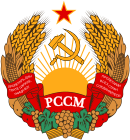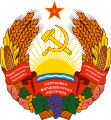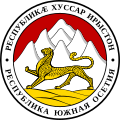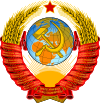
The State Flag of the Union of Soviet Socialist Republics, or simply the Soviet flag, was a red banner with two communist symbols displayed in the canton: a gold hammer and sickle topped off by a red five-point star bordered in gold. The flag's design and symbolism are derived from several sources, but emerged during the Russian Revolution. It has also come to serve as the standard symbol representing communism as a whole, recognized as such in international circles, even after the dissolution of the Soviet Union in 1991.

The hammer and sickle is a communist symbol representing proletarian solidarity between agricultural and industrial workers. It was first adopted during the Russian Revolution at the end of World War I, the hammer representing workers and the sickle representing the peasants.

The flag of the Moldavian Soviet Socialist Republic was adopted on 31 January 1952. The flag has three horizontal bands of red, green (1/4) and red, with a hammer and sickle in the canton. As defined by the Presidium of the Supreme Soviet of the Moldavian Soviet Socialist Republic on the flag description:
The national flag of the Moldavian Soviet Socialist Republic consists of a panel of red color with a green stripe in the middle of the whole flag length, with the image on top of the red part of the flag from the flagpole golden hammer and sickle above a five-pointed red star framed by gold border. The ratio of the flag's width to its length is 1:2 with the bandwidth of green to the width of the flag 1:4

A red star, five-pointed and filled, is a symbol that has often historically been associated with communist ideology, particularly in combination with the hammer and sickle, but is also used as a purely socialist symbol in the 21st century. It has been widely used in flags, state emblems, monuments, ornaments, and logos.
The flags of the Soviet Socialist Republics were all defaced versions of the flag of the Soviet Union, which featured a golden hammer and sickle and a gold-bordered red star on a red field.
Transnistria is a region in Eastern Europe that is under the effective control of the Russian-backed Pridnestrovian Moldovan Republic but is recognized by the international community as an administrative unit of Moldova, the Administrative-Territorial Units of the Left Bank of the Dniester. The flag of the Pridnestrovian Moldovan Republic is a red-green-red triband, while the Administrative-Territorial Units of the Left Bank of the Dniester use the flag of Moldova.
Transnistria is a region in Eastern Europe that is under the effective control of the self-declared Pridnestrovian Moldavian Republic but is recognized by the international community as an administrative unit of Moldova, the Administrative-Territorial Units of the Left Bank of the Dniester.
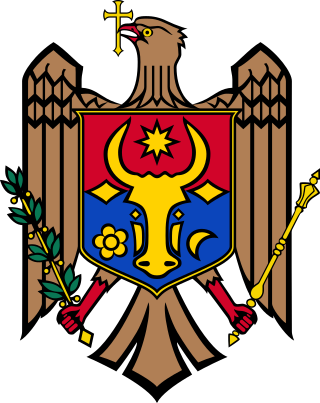
The coat of arms of Moldova is the national emblem of the Republic of Moldova.
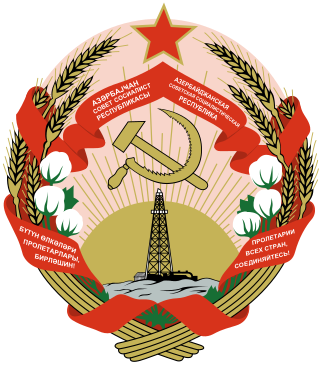
The national emblem of the Azerbaijan Soviet Socialist Republic was adopted in 1937 by the government of the Azerbaijan Soviet Socialist Republic. The style is based on the emblem of the Soviet Union.

The coat of arms of the Kazakh Soviet Socialist Republic was adopted on March 26, 1937, by the government of the Kazakh Soviet Socialist Republic. The coat of arms is based on the coat of arms of the Soviet Union.

The coat of arms of the Kirghiz Soviet Socialist Republic was adopted on March 23, 1937, by the government of the Kirghiz Soviet Socialist Republic. The coat of arms is based on the coat of arms of the Soviet Union. It shows symbols of agriculture on a backdrop of the Ala-Too mountain ranges, surrounded by a frame of folk art of the Kyrgyz people. The red star was added in 1948. The rising sun stands for the future of the Kyrgyz nation, the star as well as the hammer and sickle for the victory of communism and the "worldwide socialist community of states".

The Emblem of the Turkmen Soviet Socialist Republic was adopted on 2 March 1937 by the government of the Turkmen Soviet Socialist Republic. The coat of arms is based on the coat of arms of the Soviet Union. It shows symbols of agriculture and heavy industry, as well as a symbol of the Turkmen people, a rug. The rising Sun stands for the future of the Turkmen nation, the red star as well as the hammer and sickle for the victory of Communism and the "world-wide socialist community of states".

Emblem of the Latvian SSR was adopted on August 25, 1940, by the government of the Latvian SSR. It was based on the emblem of the Soviet Union. It features symbols of agriculture (wheat) and Latvia's maritime culture. The red star as well as the hammer and sickle for the victory of communism and the "world-wide socialist community of states".

The emblem of the Lithuanian Soviet Socialist Republic was adopted in 1940 by the government of the Lithuanian Soviet Socialist Republic. The emblem was designed by Vsevolodas Dobužinskis based on the State Emblem of the Soviet Union. The new coat of arms replaced the traditional coat of arms of Lithuania, known as Vytis, which was restored when Lithuania declared its independence in 1990.

The coat of arms of the Moldavian Soviet Socialist Republic was adopted on 10 February 1941 by the government of the Moldavian Soviet Socialist Republic. The coat of arms is based on the coat of arms of the Soviet Union. It shows symbols of agriculture, an outer rim featuring wheat, corn, grapes and clover. The red banner bears the Soviet Union state motto in both the Romanian language and the Russian language. In Romanian, it was initially "Пролетарь дин тоате цэриле, униць-вэ!"; then, from the 1950s "Пролетарь дин тоате цэриле, уници-вэ!". Both are written in the Latin alphabet as "Proletari din toate țările, uniți-vă!". The acronym MSSR is shown only in Romanian in Moldovan Cyrillic ("РССМ"). The emblem was replaced on 3 November 1990 by the present coat of arms of Moldova. Currently, the unrecognized breakaway state of Transnistria uses a similar state emblem.
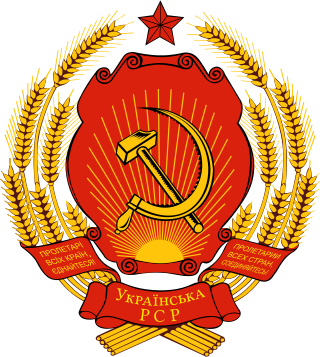
The coat of arms of the Ukrainian Soviet Socialist Republic was adopted on 14 March 1919 by the government of the Ukrainian Soviet Socialist Republic and subsequently modified on 7 November 1928, 30 January 1937 and 21 November 1949. The coat of arms from 1949 is based on the coat of arms of the Soviet Union and features the hammer and sickle, the red star, a sunrise and stalks of wheat on its outer rims. The rising sun stands for the future of the Soviet Ukrainian nation, the red star as well as the hammer and sickle for communism and the "world-wide socialist community of states".

Socialist-style emblems usually follow a unique style consisting of communist symbolism. Although commonly referred to as coats of arms, most are not actually traditional heraldic achievements. Many communist governments purposely diverged from heraldic tradition in order to distance themselves from the monarchies that they usually replaced, with coats of arms being seen as symbols of the monarchs.
The coat of arms of the Moldavian Autonomous Soviet Socialist Republic was the official emblem of the Moldavian Autonomous Soviet Socialist Republic in the Soviet Union, and underwent a number of changes over time.

The State Emblem of the Soviet Union was adopted in 1923 and was used until the dissolution of the Soviet Union in 1991. Although it technically is an emblem rather than a coat of arms, since it does not follow traditional heraldic rules, in Russian it is called герб, the word used for a traditional coat of arms.
The emblems of the autonomous republics of the Union of Soviet Socialist Republics are the heraldic symbols of the respective Autonomous Soviet Republic.
















